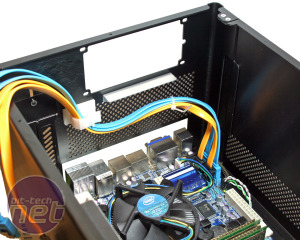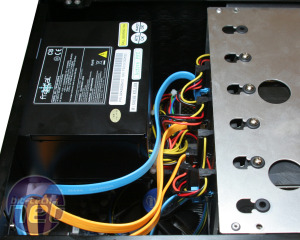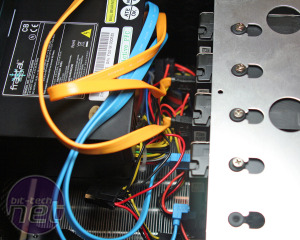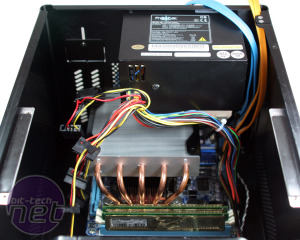
Using the Fractal Design Array R2
While we've found the Array R2 a bit hit and miss so far, things got worse the more we used the case. For starters, you really have to build your system in a particular order otherwise it's extremely fiddly work getting your hands into the case. Our advice is to remove the PSU, plug in and route all the SATA cables (using the included sticky clip), before replacing the PSU.Ideally, the Array R2 needs removable sides so that you can get at the various connectors and tody up the cabling. We'd also rather lose the subtle aesthetic curves at the back in favour of support pillars instead.


Removing the PSU and then routeing the SATA cables is an absolute must when building your system. Click to enlarge.
With a full stack of hard disks installed you'll want to use the 90-degree SATA connectors, or at least stubby ones, because they jut right up against the power supply. For an area of obviously high cable density there's little space and cable routeing help. Any attempt to try other routes is made worse by the ice cream tub-like design.
If you are trying to get some sort of cable order once everything's in the case, there's also a significant risk of pushing and breaking a SATA connector on a hard disk. As there's no easy way to attach the SATA connectors withe PSU installed, it's imperative that you get the cables as neat as you want them before re-installing the power supply.
The space inside the Array R2 hasn't been used to its utmost - there's a huge two inch gap under the hard drive cage that does absolutely nothing, for example. In addition, two of the hard disks at the very edges of the case don't get cooled at all by the large front intake fan, and because the drive cage overlaps the motherboard, larger CPU coolers such as the SilverStone NT06-E don't fit.
As it is, the Array R2 is either too big or too small - there's too much wasted space for a mini-ITX case, and making the case a touch bigger would have unlocked micro-ATX compatibility. For example, if the case had been widened by two PCI-E slots, there would not only be room for a larger motherboard, but also more cooling for the hard disks.
We're still not sure why the hard disks are mounted on their sides either - the case is tall enough that it would have been better to drop the drives in end-on and mounted them facing upwards. Mounting them with their connectors facing upward would make cabling far easier, and would allow drive to be added or removed without requiring you to strip our the entire drive enclosure.

MSI MPG Velox 100R Chassis Review
October 14 2021 | 15:04










Want to comment? Please log in.